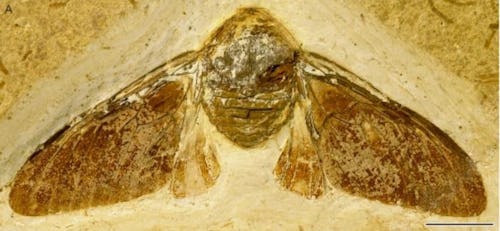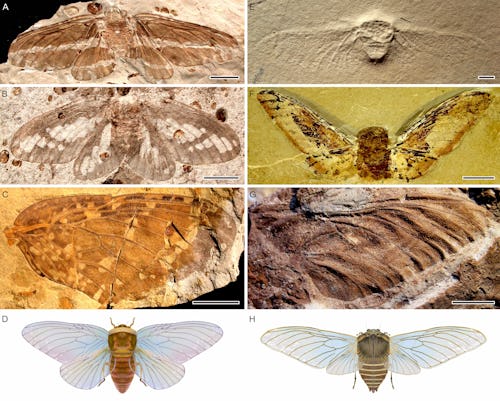
When dinosaurs thundered across the land, a giant, cicada-like bug called Palaeontinidae flew in the sky and fed on tree sap. But something disturbed its peaceful existence — and triggered the evolution of wings that could dart it away quickly, according to a new paper out this week.
These giant bugs were big, fat, and slightly hairy, living an idyllic life munching on the sticky substance inside woody trees, plants that had only just arrived on the global scene. Palaeontinidae couldn’t make a big noise like modern cicadas. But they were large, with a wingspan half a foot across. Despite their spooky size, something triggered these massive insects to adapt.
“Why would they suddenly want to develop fast flight? The answer seems to be the air,” Edmund Jarzembowski, insect paleontologist and co-author of a new paper published Friday in the journal Science Advances, tells Inverse.

Danger is a great motivator. When the research team looked at the bug’s fossils, they developed an understanding about the aerial dynamics these giant cicadas were capable of. They found “remarkable” improvements since the Palaeontinidae’s family tree first emerged at the end of the Permian, the time right before the dawn of the dinosaurs. As dinosaurs evolved through the Triassic and Jurassic, Palaeontinidae evolved too, boasting increased flight speed and enhanced maneuverability.
Their need for speed overlaps with the rise of birds. For paleontologists, that’s unlikely to be a coincidence.
“I think they were trying to stay alive,” Jarzembowski says. The Palaeontinidae was a yummy “flying wedge” packed with protein and muscle. Going out the sides, these bugs had wings Jarzembowski calls “wonderful.” At the height of their evolution, the Palaeontinidae front wings pointed forward, and joined together with the back wings to zip through the air from one point to another. “They could certainly get a move on.”

Insects were the first animals with powered flight on Earth, Jarzembowski says. Long before dinosaurs, giant dragonflies and other massive bugs carved out a niche. But it was during the age of dinosaurs, the Mesozoic, that you first get flying predators.
“We’ve got an arms race in slow motion over 160 million years,” Jarzembowski says, that began in the Triassic and reached a peak as the Jurassic period transitioned into the dinosaurs’ final geological chapter, known as the Cretaceous. It’s a grand story of survival, he says. “I mean, look at the length of how long they survived before they became extinct there.”
When the first birds bloomed, they were hungry. They probably weren’t sharing the food of the giant cicadas, either. “I don't know of any bird that relies on tree sap,” Jarzembowski says. The tree liquid is not that nutritious, he adds. “You have to drink gallons of the stuff.”

Birds would have had a harder time snagging the later versions of the giant cicadas, when the insect species developed anteromotoric flight. Here, the bug’s motion is driven primarily by the front wings. The hind wings were coupled mechanically with them, flapping in sync with the front pair.
But like many animals of the time, they went extinct, and scientists don’t currently understand why. Jarzembowski hopes to learn more about these long-lost bugs if a fossil of their larva one day appears. New computer models could put their mathematics to the test, and recreate the way the wings would have actually flown.
Jarzembowski’s big wish is to receive a phone call that they didn’t perish alongside the dinosaurs. If they managed to survive the mass extinction at the end of the Cretaceous, it would add considerably to the tale of their hardiness. But they nevertheless managed to survive 160 million years on Earth, a good record. In their wake, Jarzembowski says these giant insects have “left us all wondering and admiring them.”
FTTT
0 Comments